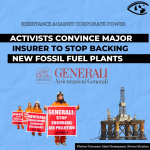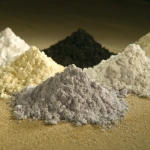USA: Closing the Lid on the Chlorine Industry
The Chlorine Chemistry Council (CCC) has reason to be worried about Joe
Thornton's new book. CCC's members -- Dow Chemical, Occidental Petroleum,
PPG, Vulcan Chemical, among others -- sell chlorine to a customer base
that makes everything from polyvinyl chloride (PVC) plastics to
pesticides.
Thornton is a research fellow at Columbia University's Center for
Environmental Research and Conservation. His forthcoming book, Pandora's
Poison: Chlorine, Health and a New Environmental Strategy (March 2000, MIT
Press), argues that chlorine and the organochlorine chemicals made from it
pose a global health and environmental threat.
Thornton says that evidence exists linking low-level organochlorine
exposure to an increased risk of cancer, infertility, impaired child
development, and disrupted immune systems. "The case is not proven, but
there's enough evidence to cause real concern," he says.
Thornton advocates a broad policy that would require industry to phase-out
chlorine-based technologies in favor of cleaner alternatives. He says we
must do away with a regulatory system that looks at one chemical at a
time, and replace it with a precautionary approach that addresses major
classes of chemicals and industrial processes.
We spoke with Thornton about his book, and he began the conversation by
launching into a chemistry lesson.
Chlorine is one of the universe's basic elements. In nature, it exists
almost solely in the form of salt -- sodium chloride, the extremely stable
ionic form of chlorine that is abundant in the seas and in everyone's salt
shaker.
The environmental issue is not with salt but with chlorine gas and the
chemicals that the chemical industry makes from it.
Chlorine gas is produced at very large chemical facilities that take a
solution of saltwater and zap it with an incredibly powerful electric
current, producing an entirely new substance, chlorine gas, a heavy
poisonous gas that was used as a chemical weapon in World War I.
Chlorine gas combines rapidly with organic matter and produces a new class
of chemicals called organochlorines.
Organochlorines are generally foreign to nature, but they are produced by
the chemical industry in huge amounts -- millions of tons per year. They
tend to be extremely toxic, many of them are very long living in the
environment, and they tend to be fat soluble, which means they build up in
the tissues of human beings and other organisms.
The first uses of chlorine gas were to bleach paper and to disinfect
drinking water. Now the main uses are to produce plastics, other
industrial chemicals, and pesticides, and also to bleach paper. It is
still used for disinfection, but in relatively small amounts. About one
percent goes to disinfect drinking water, and about four percent in the
United States goes to disinfect sewage. The other 95 percent goes to
industrial uses.
The biggest one by far is the production of polyvinylchloride (PVC)
plastic, which most people know as vinyl. Over 40 percent of the chlorine
in the United States goes to make this plastic, which is one of the most
environmentally problematic substances in our society because of the huge
quantities of toxic chemicals produced during its manufacture, use, and
disposal.
According to Thornton, anywhere you go on the earth right now, you can
find a stew of hundreds of long-lived organochlorines in the air, in the
water, in the food chain, in the bodies of people.
Even if you go to the high arctic, thousands of miles from any known
source of these chemicals, you will find some very high concentrations of
PCBs, dioxins, DDT, atrazine and other chlorinated pesticides, and a host
of other organochlorines.
"This has happened because these chemicals don't break down in the
environment, so over a very long periods of time, they are distributed
around the globe on currents of wind and water," Thonrton told us. "They
also build up through the food chain. The highest levels build up end up
in species that are high in the food chain -- species like polar bears,
whales, seals, and human beings."
Human children receive some of the highest organochlorine doses of all,
because breast feeding is an efficient way of transferring organochlorines
that have accumulated in the mother's body into the body of the child.
These chemicals also cross the placenta. These exposures occur during the
most sensitive periods of development.
And these are not exposures that people can prevent.
"Because the chemicals are absolutely everywhere, there is no way to get
away from them," Thornton said "They are in the food chain, they are in
the air and the water. It is not a matter of making healthy consumer
choices. There is no escape from these chemicals -- all we can do is
prevent further pollution."
To get these hazardous chemicals off the market, under the current system,
the regulatory police must prove that the chemicals are harmful. Thornton
says that since there are 11,000 organochlorines on the market, plus
thousands more that are formed as accidental byproducts -- many of which
haven't been identified -- it would be impossible to effectively test them
all.
Instead, Thornton says, we should scap the current system and replace it
with a system that requires the corporations to prove that the chemicals
are safe -- a system that's largely in place to regulate pharmaceuticals,
for example.
"Chlorine chemistry is a pandora's box, opened less than 100 years ago and
still spewing its demons into the environment," Thornton writes. "While
governments, cheered on by those who benefit from the open box, tried to
chase down each and every tiny demon that escapes, we miss the simplest
and most obvious solution -- close the lid."
Russell Mokhiber is editor of the Washington, D.C.-based Corporate Crime
Reporter. Robert Weissman is editor of the Washington, D.C.-based
Multinational Monitor. (c) Russell Mokhiber and Robert Weissman
- 107 Energy



